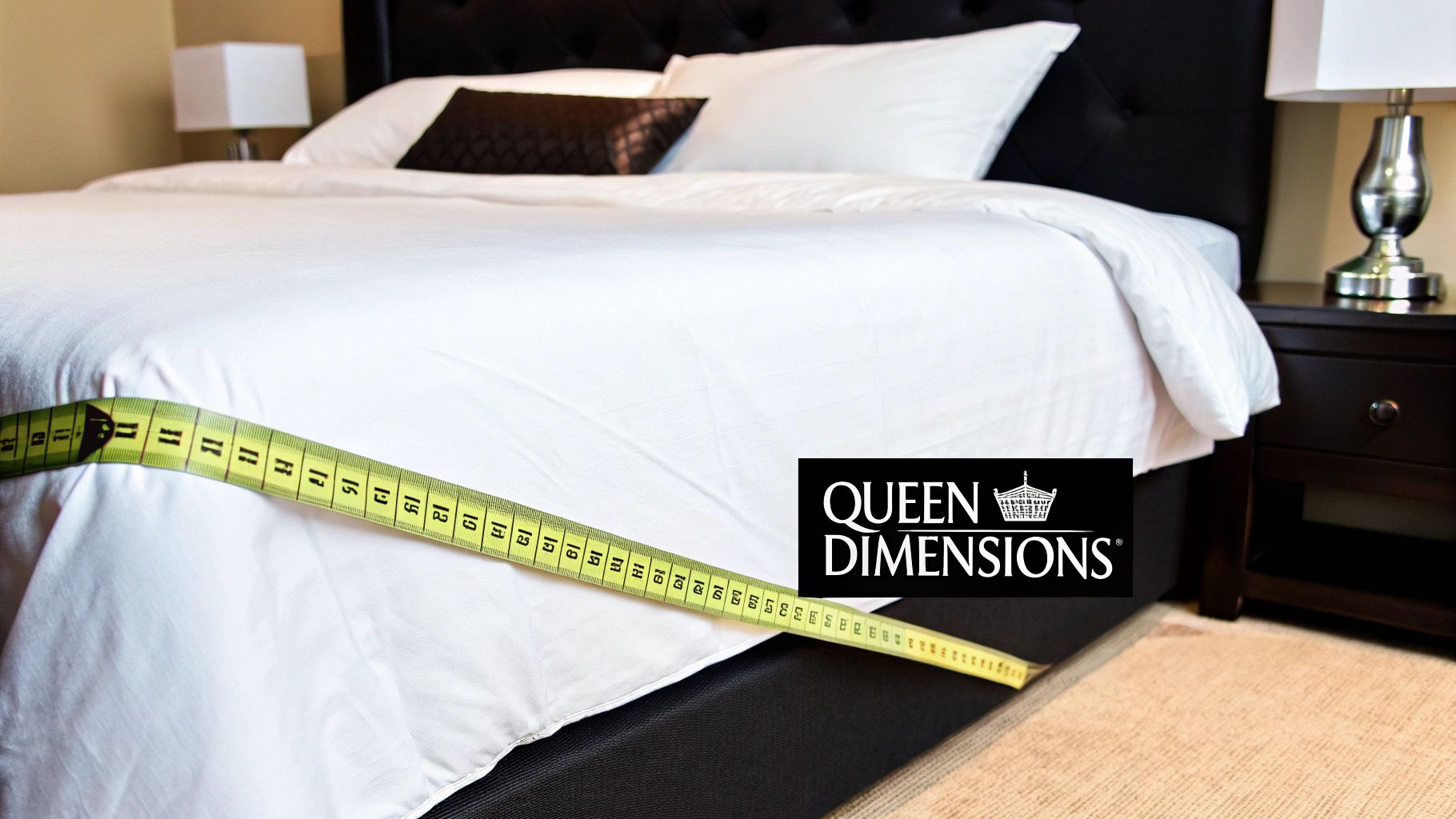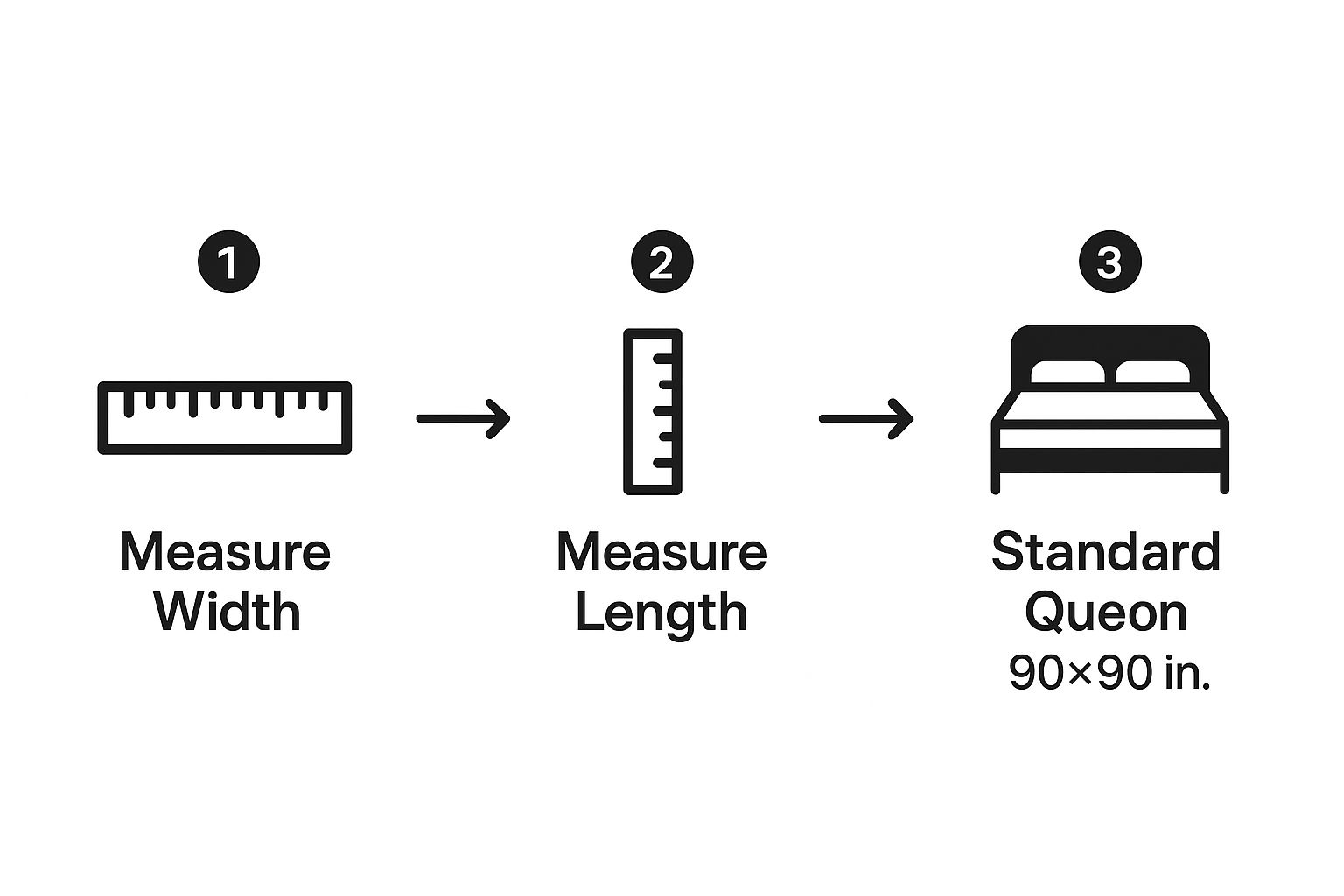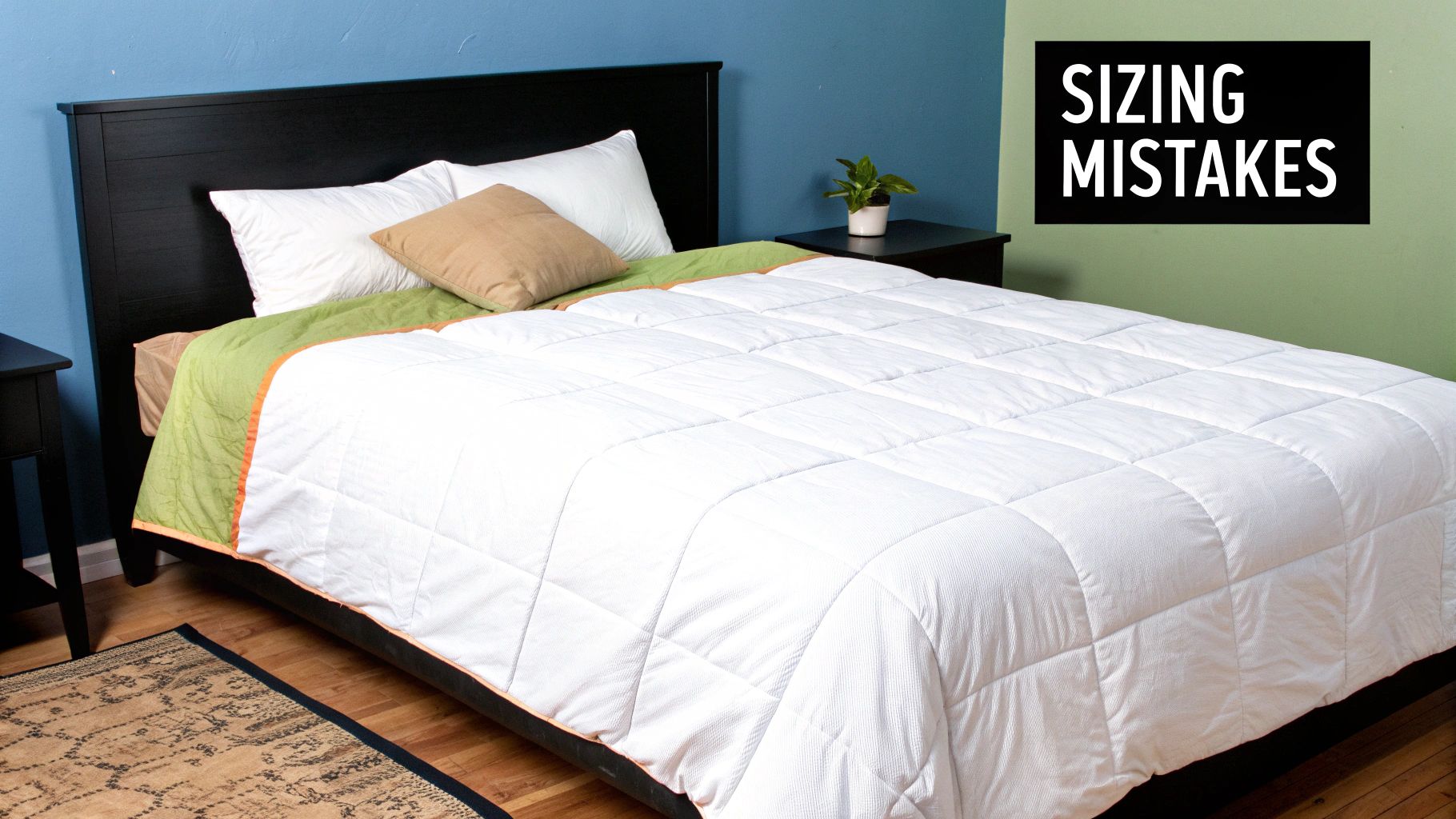When you’re looking for a new duvet cover for your queen bed in New Zealand, the number you need to remember is 210cm by 210cm. This is the standard size, creating a perfect square that’s designed to fit beautifully over your bed. Think of it like a perfectly tailored coat – not too big, not too small, but just right for a polished and cosy look.
What Makes This the Standard Queen Size?
Getting the dimensions right is the secret to a well-made bed. It’s not just about looks; it’s a practical system where every piece works together. The standard NZ queen duvet cover is sized this way on purpose, giving you that plush, inviting feel while making sure you’re properly tucked in all night.
This specific size helps you avoid two common bedding frustrations: the duvet inner getting lost and swimming inside a cover that’s way too big, or bunching up because the cover is too snug. The goal is always a smooth, seamless fit.
To help you visualise how everything comes together, here’s a quick breakdown of standard queen bedding sizes in New Zealand.
NZ Queen Bedding Size Quick Reference
This table shows how the different layers of your queen bed are designed to work in harmony.
| Bedding Item | Standard NZ Size (cm) |
|---|---|
| Queen Mattress | 153cm x 203cm |
| Queen Duvet Inner | 210cm x 210cm |
| Queen Duvet Cover | 210cm x 210cm |
Notice how the duvet inner and its cover share the exact same dimensions? That’s the key to a perfect match. They are both quite a bit wider than the mattress itself, which typically measures around 153cm by 203cm. This generous sizing allows for a lovely overhang on the sides and foot of the bed, which not only looks fantastic but also keeps you covered.
The perfect fit isn’t just about numbers; it’s about creating a sleep sanctuary. When your duvet cover fits correctly, the bed looks neater, feels more comfortable, and transforms your bedroom into a more restful space.
Getting these fundamentals right is your first step. For a complete look at how different bed sizes compare, you might find our detailed guide on NZ duvet cover sizes really helpful. This knowledge will help you shop with confidence and sidestep those all-too-common sizing mistakes.
Why Finding the Right Fit Can Be Tricky

If finding the perfect size of queen duvet cover was as simple as matching a label, we’d all get it right every time. But the reality is often quite different. Many of us know the frustration of a duvet inner that either gets lost inside a cavernous cover or bunches up uncomfortably in one that’s just a bit too snug. This common headache usually comes down to a few factors that go beyond the simple "queen" tag.
One of the biggest culprits is the global marketplace. With so many international brands available here in New Zealand, you're not always comparing apples with apples. A "queen" size from an American or European brand, for instance, can be wider or longer than what we consider standard, leading to a sloppy, ill-fitting look. It pays to be a bit of a detective and look past the name to the actual centimetre dimensions on the packaging.
Beyond the Label: The Impact of Loft
Another crucial piece of the puzzle is the 'loft'—or the thickness and fluffiness—of your duvet inner. A plush, high-loft feather and down inner will naturally fill out a cover much more than a thin, lightweight summer quilt will. It's not just the duvet's loft, either. The height of your mattress plays a huge role, especially if you have a deep pillow-top or use a separate mattress topper. These can add significant height, changing how your duvet drapes over the sides.
A standard duvet cover can end up looking skimpy on a particularly tall bed, barely covering the sides of the mattress. This is where relying on the label alone can lead you astray if you haven't considered your bed's total height from the floor up.
The perfect drape is a balance of width, length, and height. Ignoring your mattress's depth is like buying a suit jacket without considering your shoulder width—it simply won't hang right, no matter what the label says.
The standard New Zealand queen duvet cover, at 210 cm by 210 cm, is a great example of local adaptation. This square dimension was settled on to better suit the mattress sizes most common in Kiwi homes, which can differ from international norms. Local linen specialists have been working with these dimensions for well over a decade to ensure a better fit for our beds.
Getting your head around these variables is the key to avoiding those annoying and costly bedding mistakes. The same principles apply when you're choosing other bed linens. If you're looking to get your whole setup right, our guide on how to choose the right sheet set for your bed size in NZ is a great next step.
Measure Your Bed for a Flawless Fit
Ever bought a queen duvet cover only to get it home and find it just… doesn't quite work? It's a common frustration. The secret to getting that plush, perfectly styled bed you see in magazines isn't guesswork; it's a tape measure. Taking a few moments to measure your bed properly is the single best thing you can do to guarantee a flawless result.
First, lay your current duvet inner on a flat surface and measure it from seam to seam. This gives you the exact dimensions you need your new cover to be. Next, turn your attention to the mattress itself. You'll need the width and length, of course, but the most crucial and often-forgotten measurement is its height. Don't forget to include any mattress toppers in this dimension, as they can add a surprising amount of depth.
A deeper, more luxurious mattress needs a wider duvet. If you don't account for that extra height, the duvet won't have enough fabric to drape elegantly over the sides, leaving your bed looking a bit skimpy.

These are the simple, core measurements that make all the difference between a good fit and a great one.
The Designer Trick for an Opulent Look
Want to know a styling secret we use all the time for an exceptionally luxurious look? Try using a King size duvet on a Queen bed. A standard NZ King duvet is 245 cm wide, which gives you an extra 35 cm to play with compared to a standard Queen.
This simple switch pays off in two big ways:
- An Opulent Drape: The extra fabric cascades over the sides of the bed, creating that sumptuously full and inviting look that feels incredibly high-end.
- Practical Comfort: If you share a bed, that extra width puts an end to the nightly tug-of-war for the covers. Everyone stays cosy.
Expert Tip: This oversized technique looks best on beds with a standard or tall base. If your bed frame is very low to the ground, a king duvet might puddle on the floor. It's all about balancing proportions, so keep your bed's total height in mind.
This principle of measuring first holds true for all aspects of home styling. Just as with bedding, the same logic of measuring for a perfect fit applies to things like window treatments, ensuring every element in your room looks intentional and professionally done. A few minutes with a tape measure is a small investment for a perfectly curated space.
Choosing Materials That Match Your Lifestyle

While getting the right size of queen duvet cover is the first step, the material you choose is what truly defines how your bed feels night after night. The fabric dictates everything from the texture against your skin to how much effort it takes to maintain. It’s a bit like picking an outfit – the fit is important, but it’s the fabric that makes it comfortable and right for the occasion.
Your own lifestyle and preferences are the best place to start. Are you hoping to recreate that five-star hotel feeling, or do you need something practical that can stand up to kids, pets, and lazy weekend mornings? Each fabric offers a completely different experience.
For instance, a crisp percale cotton feels cool and breathable, which is perfect if you tend to overheat while you sleep. On the other hand, a sateen weave gives you a buttery-soft, silky touch with a slight lustre, creating a much more opulent and luxurious bed.
Finding Your Perfect Fabric Feel
Ultimately, deciding on a material is all about the kind of sensory experience you want to drift off in. Every option brings its own personality to your bedroom sanctuary.
- Linen: Known for its relaxed, lived-in charm that only gets softer with each wash. Linen is also incredibly breathable and a natural temperature regulator, so it keeps you cool when it's warm and cosy when it's not.
- Flannel: The undisputed champion of cold nights. Its brushed, fuzzy surface is exceptionally soft and does a brilliant job of trapping body heat, turning your bed into a snug nest.
- Natural Fibres: When you’re choosing, the material is just as crucial as the size. For those leaning towards natural fabrics, exploring options like bamboo duvet cover sets can deliver on both comfort and style, as they're often celebrated for their incredible softness and sustainable qualities.
Think of your duvet cover as more than just a protective layer. It's the main texture you feel every single day. Investing in a material that truly suits your comfort needs is what transforms your bed from a piece of furniture into a genuine personal haven.
The best choice is one that fits seamlessly into your daily life. A durable, easy-to-wash cotton might be the practical pick for a busy family, whereas a beautiful, high-end linen is often better suited to a quiet, adult-focused space. Choosing wisely means you'll love your duvet cover just as much for its feel as for its fit.
Style Your Bed Like a Professional
Once you've got your perfectly sized duvet cover, you can think of it as the canvas for your bed. A duvet that fits just right is the foundation, but the styling is what truly transforms your bed from just another piece of furniture into the inviting centrepiece of your bedroom. The good news is that those plush, inviting beds you see in magazines are created with simple techniques anyone can master.
The real secret lies in layering different textures to create depth and interest. Look beyond just the duvet cover and start thinking about other materials you can introduce. A chunky knit throw folded neatly at the foot of the bed, or perhaps a soft velvet cushion propped against your pillows, can make a world of difference. This mix-and-match approach adds visual weight and a tactile, cosy feeling that practically begs you to dive in.
The Art of Pillow Arrangement
The way you arrange your pillows can completely change the entire look of your bed. It’s not just about getting comfortable; it’s a design choice that builds height and structure. A well-styled bed nearly always uses a combination of different pillows to get that full, deliberate look.
- Start with European Pillows: First, stand two large European square pillows (typically 65cm x 65cm) upright against your headboard. They act as a tall, solid backdrop for everything else.
- Add Your Sleeping Pillows: Next, place your standard queen pillows in front of the European ones. These are the practical, everyday pillows you’ll actually be sleeping on.
- Finish with Accent Cushions: Now for the fun part. Add one to three smaller, decorative cushions in the very front. This is your chance to play with a bold colour, an unusual shape, or an interesting pattern to tie the whole look together.
The goal is to build a visually appealing gradient of height and texture, leading the eye from the front of the bed right up to the headboard. A neutral duvet paired with vibrant accent cushions is a classic combination that always looks sophisticated.
By combining the right size of queen duvet cover with thoughtful styling, you create a space that’s not just beautiful but also feels incredibly personal. These small details are a huge part of the art of sleeping well and choosing the right bed linen for you.
Your Queen Duvet Cover Questions Answered
 Even with all the measurements and guides, you might still have a few lingering questions before you commit. It’s completely normal! Choosing the right bedding is a big decision, and it’s easy to get caught up in the details.
Even with all the measurements and guides, you might still have a few lingering questions before you commit. It’s completely normal! Choosing the right bedding is a big decision, and it’s easy to get caught up in the details.
This section is here to clear up those last-minute doubts. We’ll cover the common practical questions that pop up, giving you the final bit of confidence you need to get it just right.
Can I Use a King Size Duvet on a Queen Bed?
You certainly can, and it’s a great interior styling trick we often recommend. Putting a king size duvet on a queen bed creates that wonderfully plush, hotel-luxe look. The generous overhang on the sides looks inviting, and it's a game-changer if you’re sharing the bed and battling a cover-hog!
An NZ king duvet inner is 245 cm wide, while a queen is 210 cm, so you gain a good amount of extra drape. Just one thing to keep in mind: your bed's height. If you have a low-profile frame, a king duvet might puddle on the floor. This trick works best for beds that are a standard height or taller.
What Is the Difference Between a Duvet Cover and a Comforter?
Think of it this way: a duvet cover is to your duvet inner what a pillowcase is to your pillow. It’s a protective sleeve that you can easily take off and wash. This also means you can completely change the look of your bedroom just by swapping out the cover.
A comforter, on the other hand, is a single, self-contained piece. The filling is stitched right into the decorative outer fabric. While they seem convenient, comforters are often too bulky for a standard washing machine and don't give you the freedom to easily refresh your style.
A duvet cover gives you two massive wins: it protects your inner, and it lets you change your bedroom's colour and style in minutes. A comforter is an all-in-one unit that locks you into a single look.
Will My Duvet Fit If It Is Slightly Bigger Than the Cover?
Actually, a duvet inner that’s a few centimetres larger than its cover can be a secret weapon for a better-looking bed. It helps the duvet feel much fuller and loftier inside the cover. More importantly, it stops the inner from sliding around and bunching up at the bottom, which is a common frustration.
As a rule of thumb, an inner that is the same size or up to 5 cm larger than the cover in both width and length is perfect. Anything more than that, and you’ll start to get uncomfortable lumps and a fit that just doesn't sit right.
How Do I Stop My Duvet Cover From Shrinking?
The number one enemy of fabrics like cotton and linen is high heat. The best first step is to always check the specific care label on your duvet cover, as every fabric is different.
But for natural fibres, here are some solid guidelines to follow:
- Wash your duvet cover in cold or lukewarm water and choose a gentle cycle.
- Line drying is always the best option. It’s gentle on the fibres and helps maintain the original size.
- If you have to use a dryer, select a low-heat or air-only setting and pull it out as soon as it's done.
Ready to find the perfect linen for your sanctuary? Explore the curated collections at The Foxes Den and discover timeless pieces designed to elevate your home. Find your perfect fit today.


